Transform Your Backyard Into a Professional Home Office Shed That Works
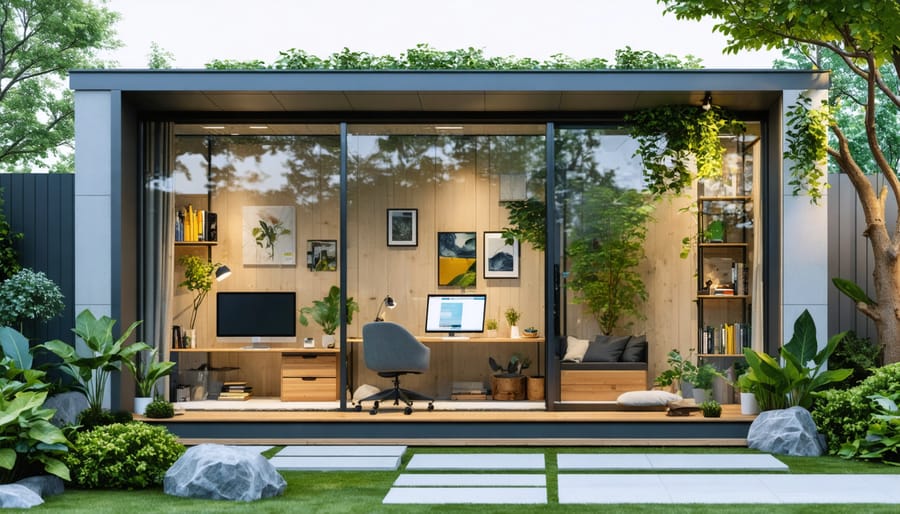
Transform your backyard into a productive workspace by learning how to design your home office shed with maximum efficiency. A well-planned shed office delivers the perfect balance of professional functionality and backyard serenity, creating a dedicated space that boosts productivity while maintaining work-life boundaries.
Modern home office sheds have evolved far beyond basic storage structures, now featuring essential amenities like proper insulation, electrical systems, and ergonomic design elements. Whether you’re a remote professional, creative entrepreneur, or digital nomad, a customized office shed provides the ideal solution for those seeking a distraction-free environment without sacrificing comfort or style.
Consider key factors like natural lighting, climate control, and connectivity infrastructure when planning your shed office. Smart design choices, such as large windows, proper ventilation, and built-in storage solutions, transform a simple garden structure into a sophisticated workspace that enhances both your property value and daily work experience. With careful planning and the right design elements, your backyard office shed becomes more than just a workspace – it’s an investment in your professional future.
Smart Design Features for Your Home Office Shed
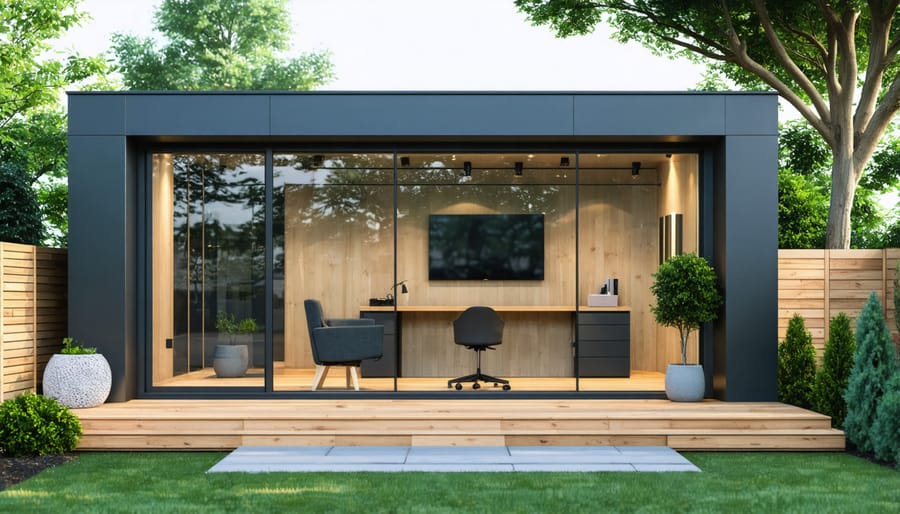
Size and Layout Planning
Planning the right size and layout for your home office shed is crucial for creating a productive workspace. Start by measuring your essential furniture pieces, including your desk, chair, and storage units. A typical home office shed should be at least 8×10 feet to accommodate basic office equipment while allowing comfortable movement.
Consider adding an extra 2-3 feet of space around your desk area for easy access and natural workflow. For optimal comfort, plan for ceiling heights of at least 7 feet, though 8-9 feet is ideal for incorporating storage solutions and preventing a cramped feeling.
When mapping out your layout, position your desk to take advantage of natural light from windows while avoiding screen glare. Create distinct zones for different activities: a primary work area, a storage section, and possibly a small meeting space if needed. Remember to account for electrical outlets, lighting fixtures, and any additional equipment like printers or file cabinets.
Many successful home office shed owners recommend including a small seating area for breaks or casual meetings. If space allows, consider incorporating built-in shelving or a murphy desk to maximize floor space. Leave about 30% of your total square footage as open space to prevent the area from feeling cluttered and maintain good airflow.
For those planning to spend full workdays in the shed, factor in space for a compact refrigerator or coffee station. This thoughtful planning ensures your home office shed remains comfortable and functional for years to come.
Natural Light and Ventilation
Natural lighting and proper ventilation are crucial elements that can transform your home office shed from a basic workspace into a comfortable and productive environment. Strategic window placement not only floods your office with energizing daylight but also helps maintain a connection with the outdoor environment, reducing the feeling of isolation while working.
Consider installing windows in your shed on multiple sides to maximize natural light throughout the day. Large windows on the north-facing wall provide consistent, glare-free light, while smaller windows on the east or west walls can offer beautiful morning or afternoon sunlight. To prevent overheating, especially during summer months, opt for double-pane windows with UV protection.
For optimal airflow, incorporate a combination of windows that can open and close, along with additional ventilation solutions. A cross-ventilation setup with windows on opposite walls creates a pleasant breeze and helps regulate temperature. Consider installing a small exhaust fan or roof vent to eliminate stale air and reduce humidity, particularly important for protecting your office equipment and maintaining comfort during extended work sessions.
Smart window treatments like adjustable blinds or cellular shades allow you to control light levels throughout the day, preventing screen glare while still maintaining the benefits of natural illumination. For added comfort, you might also want to include a small ceiling fan to keep air circulating during warmer months.
Weather Protection and Insulation
Proper insulation and weather protection are crucial for creating a comfortable year-round workspace while safeguarding your equipment. Start with a solid foundation by installing a vapor barrier beneath the floor to prevent moisture from seeping up. For walls and ceiling, opt for high-quality insulation materials like mineral wool or spray foam, achieving an R-value of at least R-13 for walls and R-30 for the ceiling.
Consider installing double-pane windows with low-E coating to regulate temperature and reduce UV damage to equipment and furniture. Weather stripping around doors and windows prevents drafts and keeps out dust, while proper ventilation through small vents or a mini HVAC system manages humidity and prevents condensation.
Your shed’s exterior needs equal attention. Choose weather-resistant siding materials like vinyl or fiber cement, and ensure proper roof drainage with gutters and downspouts. Apply exterior-grade caulk around all openings and joints to prevent water infiltration. A slight roof overhang provides additional protection against rain and direct sunlight.
For climate control, consider installing a mini-split system or portable air conditioner/heater combo. This maintains a consistent temperature that keeps you comfortable and protects sensitive electronics. Adding thermal curtains or cellular shades provides an extra layer of insulation while allowing you to control natural light throughout the day.
Remember, investing in quality weather protection upfront saves money on energy costs and prevents potential damage to your office equipment down the line.
Essential Infrastructure Components
Electrical Setup and Connectivity
A reliable power supply and strong internet connection are essential for any home office shed. Start by consulting a qualified electrician to assess your power needs and install appropriate wiring from your main house to the shed. Most home office setups require at least 4-6 power outlets for computers, printers, lighting, and climate control systems. Consider installing a dedicated 20-amp circuit to handle multiple devices running simultaneously.
For internet connectivity, you have several options. Running an ethernet cable from your house to the shed provides the most stable connection, but ensure you use outdoor-rated CAT6 cable buried in conduit for protection. Alternatively, a mesh WiFi system with outdoor nodes can extend your wireless network effectively. For areas with poor WiFi coverage, a point-to-point wireless bridge can create a reliable connection between your house and shed.
Don’t forget about proper surge protection for your electronics. Install a whole-shed surge protector at the electrical panel and use high-quality power strips for additional protection. Consider adding USB outlets for convenient device charging and plan for future expansion by including extra circuits and outlets.
For lighting, LED fixtures provide energy-efficient illumination while generating minimal heat. Include both overhead lighting and task lighting for your desk area. Motion-sensor exterior lighting adds security and convenience when working late.
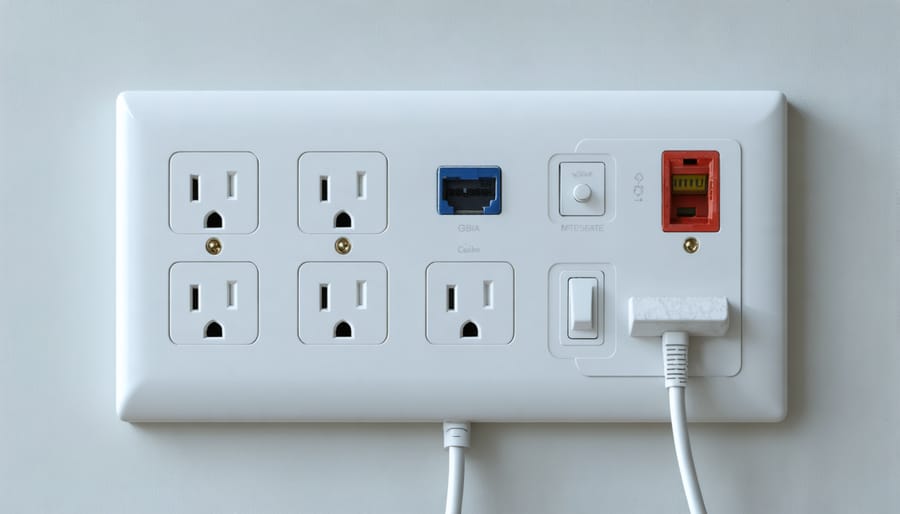
Foundation and Flooring
A solid foundation is crucial for your home office shed’s longevity and functionality. Before you start building, it’s essential to prepare your shed foundation properly to prevent moisture issues and ensure stability.
Concrete slabs are a popular choice, offering excellent durability and moisture resistance. They provide a level surface for your flooring and help maintain a consistent temperature inside your office. For a more budget-friendly option, consider a gravel bed foundation topped with concrete pavers, which offers good drainage while maintaining stability.
For the flooring itself, consider moisture-resistant options like vinyl planks or treated plywood covered with laminate. These materials are both practical and aesthetically pleasing, making them perfect for a professional home office environment. Adding a vapor barrier beneath your flooring adds an extra layer of protection against ground moisture.
If you’re in an area with freezing temperatures, don’t forget to include proper insulation in your foundation and flooring plan. Rigid foam insulation under your flooring can help maintain comfortable temperatures year-round while reducing energy costs. For added comfort, consider installing electric underfloor heating – it’s an efficient way to heat your workspace during colder months.
Remember to ensure your foundation extends slightly beyond your shed’s footprint to prevent water from pooling around the base.
Security Features
Securing your home office shed is crucial for protecting both your valuable equipment and sensitive work documents. Start with high-quality locks, including a deadbolt for the main door and window locks for all access points. Consider installing smart locks that allow remote monitoring and control through your smartphone.
Motion-sensor lighting around the perimeter of your shed serves dual purposes: deterring potential intruders and providing convenient illumination when you’re working late. Installing security cameras that connect to your home’s WiFi network gives you real-time monitoring capabilities and recorded footage if needed.
For sensitive materials, invest in a fireproof safe that’s bolted to the floor. This provides an extra layer of protection for important documents, hard drives, and backup devices. Window films or security glass can prevent break-ins while maintaining natural light.
Don’t forget about digital security. Extend your home’s WiFi security system to your shed office, using a separate network if possible. Install surge protectors and consider a small security system that connects to your home’s main alarm setup.
Temperature monitoring systems can protect your electronics from extreme heat or cold, while moisture sensors alert you to potential water damage. Remember to keep an updated inventory of all equipment and maintain proper insurance coverage for your office contents.
Interior Design and Organization
Workspace Layout
When you convert your shed into an office, smart workspace layout is crucial for both productivity and comfort. Start by positioning your desk to maximize natural light, ideally facing a window or positioned perpendicular to it. This arrangement reduces eye strain and helps maintain your natural circadian rhythm throughout the workday.
Consider the ergonomics of your setup by leaving at least 3.5 feet of clearance behind your desk chair for comfortable movement. Install adjustable shelving units on the walls to keep frequently used items within arm’s reach while maximizing floor space. L-shaped or corner desks can be excellent choices for smaller sheds, offering ample workspace without overwhelming the room.
Storage solutions should be both functional and aesthetically pleasing. Consider incorporating:
– Built-in cabinets along one wall for files and supplies
– Under-desk drawers for immediate access to essentials
– Wall-mounted organizers for documents and stationery
– Floating shelves for books and decorative items
– Cable management systems to keep wires tidy and out of sight
Remember to include a designated charging station for electronic devices and create zones for different activities – main work area, reference materials, and perhaps a small meeting space if room allows. Use vertical space efficiently with pegboards or magnetic boards for frequently accessed items.
For optimal workflow, arrange your furniture in a way that allows you to reach everything without constantly getting up. This might mean placing your printer on a rolling cart or installing a swivel chair to access different work zones easily.
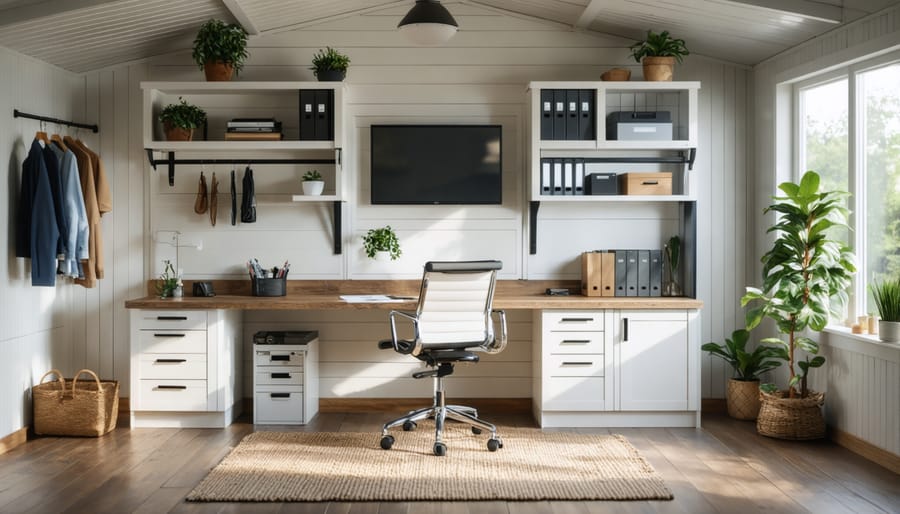
Lighting Solutions
Proper lighting is essential for a productive home office environment, and your shed workspace requires a thoughtful combination of natural and artificial lighting solutions. Start with a layered lighting approach that includes ambient, task, and accent lighting to create a well-balanced workspace throughout the day.
For ambient lighting, consider installing LED recessed lights or a modern flush-mount ceiling fixture to provide even illumination across the entire space. These fixtures should be dimmable to adjust light levels as needed. Position them strategically to avoid screen glare on your computer monitor.
Task lighting is crucial for detailed work. A versatile desk lamp with adjustable arms and multiple brightness settings will help reduce eye strain during focused tasks. Look for options with color temperature controls to match your natural circadian rhythm – cooler lights for daytime productivity and warmer tones for evening work.
Add accent lighting to create a welcoming atmosphere and reduce harsh shadows. Wall sconces or track lighting can highlight artwork or storage areas while contributing to the overall light balance. For energy efficiency, install motion sensors or smart lighting systems that automatically adjust based on time of day and natural light levels.
Don’t forget to include exterior lighting for safe access during darker hours. Solar-powered path lights or motion-activated security lights ensure you can safely navigate to and from your office shed any time of day.
Storage and Organization
Maximizing storage in your home office shed is crucial for maintaining a clutter-free and productive workspace. Start by installing wall-mounted shelving units that utilize vertical space without consuming valuable floor area. Consider adjustable shelving systems that can adapt as your storage needs change over time.
Built-in cabinets along one wall can provide substantial storage while maintaining a clean, professional appearance. Opt for floor-to-ceiling units to maximize space efficiency, and include a mix of closed cabinets and open shelving. The closed storage helps hide office supplies and paperwork, while open shelves can display books, awards, or decorative items that inspire creativity.
Under-desk storage solutions are essential for keeping frequently used items within arm’s reach. Install filing cabinets on wheels for flexibility, or choose a desk with built-in drawers. Don’t forget about often-overlooked spaces – the area behind the door can accommodate a hanging organizer for supplies, while corner spaces can be transformed with custom-built triangular shelving.
Make use of multi-functional furniture pieces to optimize your space. A window seat with built-in storage underneath can serve as both additional seating and a place to store rarely-used items. Cable management solutions, such as desk grommets and cord organizers, help maintain a tidy appearance and prevent wire tangles.
For digital workers, consider creating a dedicated charging station within a drawer or cabinet to keep devices organized and powered up. Remember to incorporate adequate lighting around storage areas to ensure easy access to all your supplies, even in corners or cabinet interiors.
Practical Implementation Tips
Permits and Regulations
Before breaking ground on your home office shed, it’s crucial to navigate local building regulations and permit requirements. Most municipalities have specific rules about auxiliary structures, including size limitations, setback requirements, and height restrictions. Start by contacting your local planning department or building authority to understand what permits you’ll need.
Common requirements include building permits, electrical permits for power installation, and possibly special zoning clearances. You’ll likely need to submit detailed plans showing the shed’s dimensions, location on your property, and intended use. Some areas also require approval from homeowners’ associations (HOAs) before construction can begin.
Keep in mind that converting an existing shed into an office space may have different requirements than building new. Following our eco-friendly shed conversion tips can help ensure your project meets both regulatory and environmental standards. Remember that failure to obtain proper permits could result in fines or even require removing the structure, so it’s worth taking the time to do things right from the start.
Consider working with a local contractor who’s familiar with area regulations to streamline the permit process and ensure compliance with all building codes.
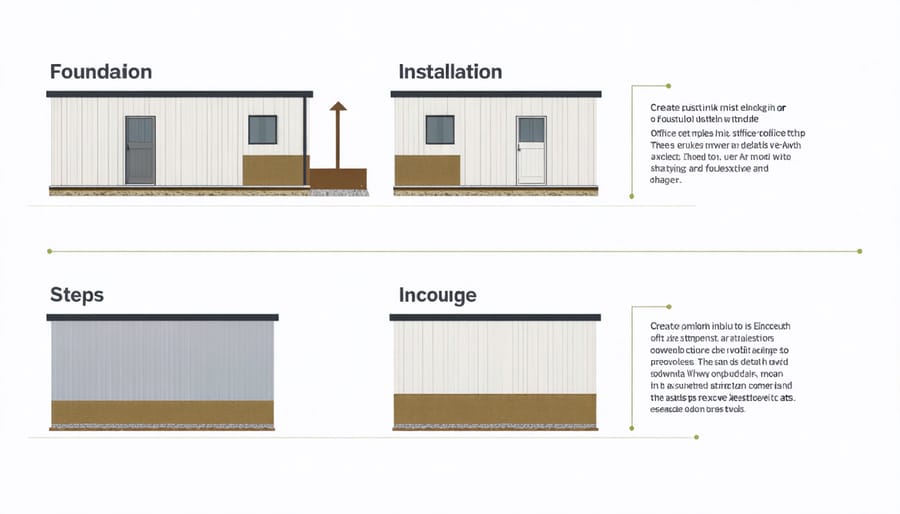
Professional vs. DIY Installation
When it comes to installing your home office shed, you’ll need to decide between professional installation and the DIY route. Professional installation typically costs more but offers peace of mind through expertise, proper tools, and warranties. Installers handle everything from site preparation to final assembly, usually completing the project within 1-2 days.
DIY installation can save you significant money, with savings often ranging from $500 to $2,000. However, you’ll need basic construction knowledge, proper tools, and enough time to complete the project. Most shed kits come with detailed instructions, and the installation typically takes 2-4 days for two people working together.
Consider your comfort level with construction projects, available time, and budget when making your choice. If you’re handy and enjoy home projects, DIY might be perfect. But if you’re unsure about foundation work or electrical installations, professional help could prevent costly mistakes. Some homeowners opt for a hybrid approach, handling simple tasks themselves while leaving complex elements like electrical work to professionals.
Creating a home office shed can transform your work-from-home experience while adding value to your property. Whether you choose a modern minimalist design or a cozy cottage-style workspace, the key is to focus on functionality without compromising comfort. Remember to consider essential factors like proper insulation, electrical setup, and natural lighting when planning your shed office. Start by obtaining necessary permits, then work with reliable contractors or tackle the project yourself if you’re DIY-inclined. With careful planning and attention to detail, you can create a productive workspace that separates your professional and personal life while making the most of your property. Take that first step today toward building your perfect backyard office sanctuary – your future self will thank you for it.

